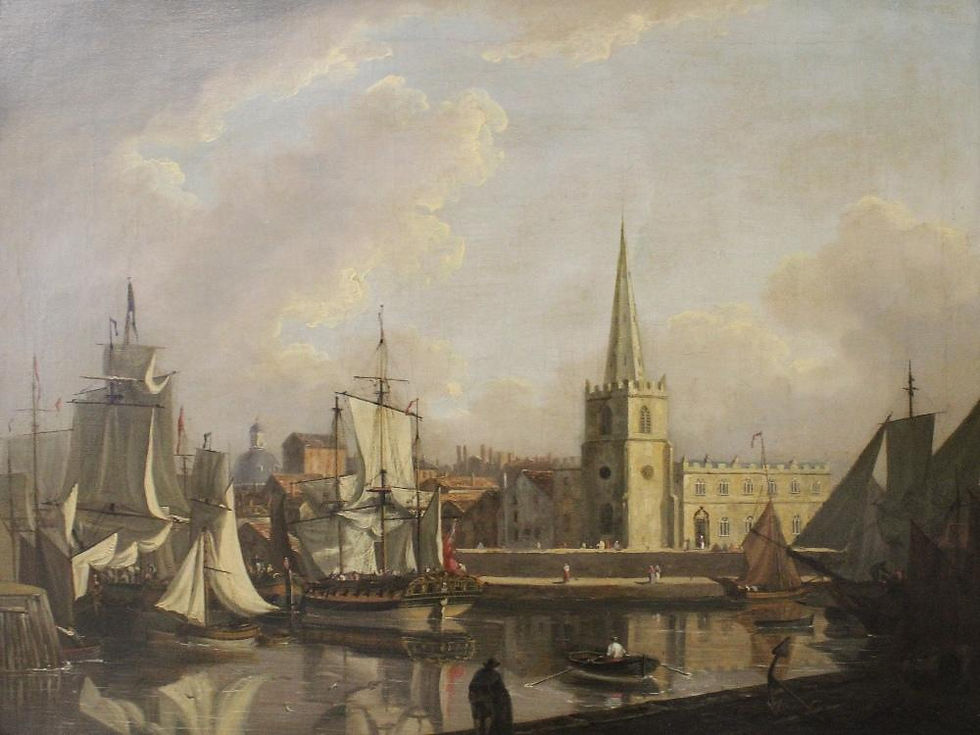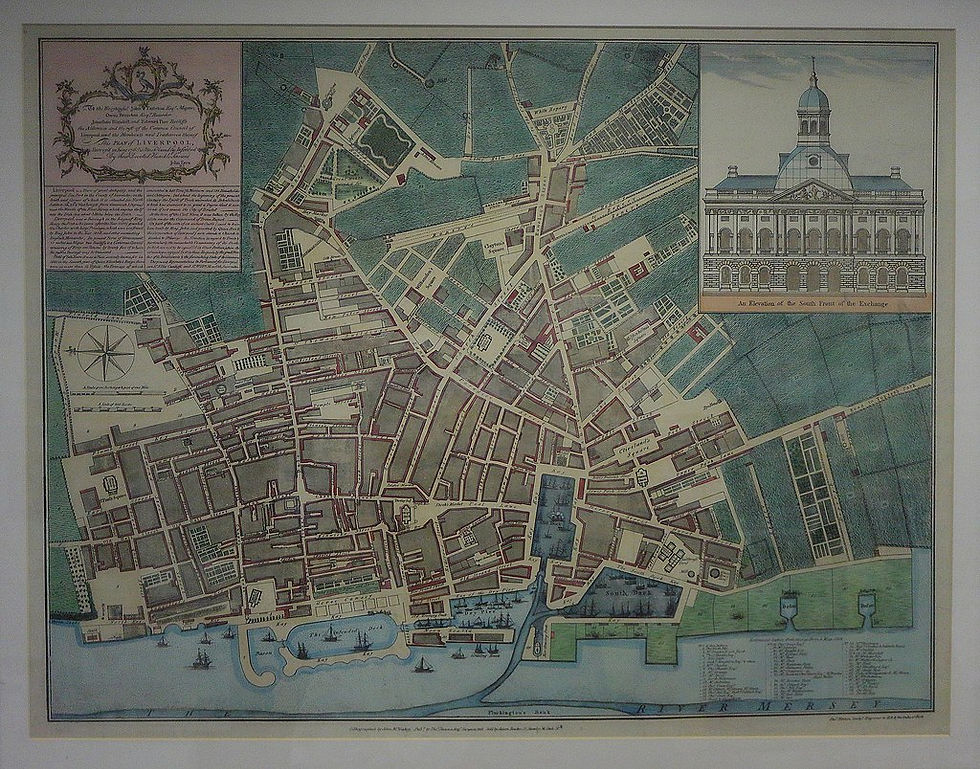Liverpool’s Eighteenth-Century Second-Hand Smoke Problem
- EPOCH

- Mar 1, 2024
- 6 min read
Dabeoc Stanley | Lancaster University

If you stepped into Liverpool in the mid-1780s you would encounter an animated, bustling, overwhelming city. Everywhere you look you would see feverish activity. Ships jostled at the docks, creating a thicket of masts that filled the skyline. There would have been a cacophony of noises as exotic goods and commodities, from around the world, were unloaded to feed the appetites of Georgian consumers and the hungry mills of Lancashire. Cotton, coffee, rum, tobacco, and sugar arrived from the Americas and Asia. In this period wealth flowed through Liverpool like water. It soon acquired all the trappings of a genteel eighteenth-century city – elegant promenades, fine houses, and street lighting.
By 1784, Liverpool was an awesome and awful place. It had grown from a modest fishing community in 1700 to the ‘second city of the British empire’ – the lynchpin of the threads of maritime trade that wove the British Atlantic together. It had also, by the 1750s, become the leading British port in the Transatlantic Slave Trade. In 1784 alone 55 ships left Liverpool for this purpose, transporting over 20,000 enslaved Africans across the Atlantic – almost 10 percent of whom died during the Middle Passage. The material fabric of the city was, to paraphrase an oft-quoted remark from 1772, cemented with the blood of the enslaved.
If you were to walk Liverpool’s streets in 1784, however, you would struggle to see this material wealth, indeed you would probably be struggling to breathe. The culprit was second-hand tobacco smoke. A petition to the Commissioners of Customs signed by more than 40 ‘respectable persons’ of Liverpool, and dated to June 1784, described:
… volumes of dense smoak … [that] cloud the streets to the annoyance of all passengers and fill the rooms of every house … to a degree perfectly offensive and intolerable … Within the reach of the smoak the furniture of our houses is spoiled, life is rendered comfortless to all, many are afflicted with sore eyes and only the young and healthy at some time can breathe.
In foggy or calm conditions, the wind was not sufficient to carry off the smoke, allowing it to accumulate in Liverpool’s streets and squares, creating a smog every bit as suffocating as that of London.
Air pollution was not a new phenomenon in Liverpool. William Moss’s 1784 Familiar medical survey of Liverpool listed a rogues’ gallery of causes: the Oil-House whose rendering of whale blubber into oil for lighting street lamps and houses emitted a smell ‘in the highest degree nauseous’, the ‘unwholesome smoke’ of numerous brick kilns, and the fumes ‘regularly and incessantly’ released by the salt-works on Salthouse Dock. These emissions were all by-products of the city’s nonstop commercial activity. By contrast, the tobacco smoke was the result of something quite different – it was the unintended result of legislation, and collateral damage from the war against smuggling.
In the eighteenth century, the maritime trade of the British Atlantic operated under mercantilist restrictions designed to favour the metropole. Under these laws, enumerated colonial goods, such as tobacco, had to be landed in Britain. Intending to encourage British merchants to export these goods to European markets, and hence create a favourable balance of trade, the Government introduced the ‘drawback’ system. If a merchant presented documents proving they had paid the duty when tobacco was landed and that it was destined for a legitimate customer outside the British Isles, they were allowed to ‘drawback’ the full value of the duties calculated by weighing the tobacco in question. Liverpool benefitted from these laws, developing into a great entrepôt of the tobacco trade, but also a centre for the illegal economy. Fraudsters exploited the system by filling hollowed-out rolls of tobacco with ‘sand, dirt, and all manner of rubish’ to receive more than their fair share of drawback money. Saleable tobacco which had been processed through schemes such as this was often landed secretly on the Isle of Man, a great storehouse for smugglers, from whence it could be run back into the British Isles to eager customers.
Smugglers made significant profits from landing contraband at the expense of the British Government’s Customs and Excise revenues. In response, Parliament imposed increasingly stringent measures regarding the handling and disposal of damaged, or contraband, tobacco. Under the 1750 Act for the more effectual securing the Duties upon Tobacco, all tobacco seized as contraband or condemned as damaged (and therefore exempted from paying duty) was required to be destroyed by burning. Across Britain, Customs officers began to regularly burn large quantities of tobacco – at Cowes in the Isle of Wight, for example, 541 lbs of tobacco were burnt between June and September 1752.

In Liverpool, the burning of condemned tobacco had originally been carried out at the ‘King’s pipe’. This was a chimney located at the foot of Water Street, the site of the former Custom House, at the edge of the sea. In this site the smoke it released impinged less on Liverpool’s inhabitants – or at least the affluent ones. It was, however, found that tobacco was frequently stolen from this isolated spot or from the carts that transported it from storage. For that reason, in 1783 the King’s Pipe was torn down, and an ‘immense chimney’ erected in the yard behind the Custom House. This was in the very heart of Liverpool, at the eastern end of the Old Dock, next to the most fashionable and desirable streets in the city. Opposition emerged almost immediately. The residents who signed the 1784 petition stated that ‘the pipe is so situated now as to distress the inhabitants of the best streets and squares in the town’ and complained about its impact on property values. They wanted the Customs officers to stop burning tobacco until ‘a fit building be erected for the purpose in a more proper place’.
Hindsight, and the benefit of modern medical knowledge, suggests that the petitioners' concerns should have been centred not upon the potential damage to their pockets, but to their health. Inhalation of second-hand smoke is a significant risk factor for contracting heart disease, cancer, or breathing problems such as asthma. When second-hand smoke is of the intensity mentioned in the petition - stinging to the eyes - it can increase the risk of age-related sight loss. There are clear indications that the high levels of air pollution in Liverpool in the 1780s contributed to health issues amongst its residents. In 1784 Moss wrote:
… affections of the breast … can be properly called endemic, or peculiar, to the town … I have known strangers … who … upon residing here in the colder seasons, have had severe coughs and obstructions of the breast, that have nearly proved fatal.
It was the poorest inhabitants of Liverpool who were most vulnerable to this pollution. In the mid-eighteenth century their dwellings were largely confined to the lowest quality of housing, and in cellars. Unlike more affluent residents they suffered from poor nutrition, limited access to healthcare, and often lacked the means to leave the city for recreation or to seek clearer air. In 1784 Moss observed that there were:
… a disease to which young children in this town are particularly incident, which so much resembles the asthma of grown persons, as not to be distinguished from it. It is discovered soon after the birth of the child, and is chiefly to be observed amongst the children of the poor …
At the time, however, people were ignorant of the dangers of tobacco smoke. It was widely thought to have medicinal qualities. Indeed, chillingly, Moss praised the newly erected Custom House chimney as ‘a convenience … for the purpose of dispersing, throughout the town, the smoke of tobacco’, noting that tobacco was ‘well known to be a powerful corrector and resister of infection and infectious disease’.
Whilst it is impossible (and ahistorical) to ascribe the degree to which the Custom House chimney was to blame for these maladies, it is credible to suggest that the decision to burn condemned tobacco in the heart of a densely populated urban area contributed to exacerbating Liverpool’s unhygienic and unhealthy state in the mid-eighteenth century. The whole affair is indicative of the disorganisation within the overstretched Customs service. Customs officers were overworked, underpaid, suffered from poor morale, and were often suspected of being in league with smugglers.
Liverpool’s Custom House had long been known to be cramped, in poor condition, and with leaky warehouses vulnerable to thieves. It was the hasty decision to erect the chimney on the premises, however, that proved destructive in more ways than one. In January 1802 during ‘a most tremendous gale’ the chimney collapsed – demolishing the roof of the Custom House ‘together with many official books and papers’. It is poetically ironic that amongst these papers was likely a record of the outcome of the 1784 petition. Despite the loss of these documents, it is possible to draw from Liverpool’s problem with second-hand smoke some intriguing and revealing observations about eighteenth-century Britain. By mandating the burning of condemned tobacco, legislation passed to combat smuggling resulted in very real public health consequences. The fiscal needs of the Revenue were put ahead of the health concerns of the populace. Liverpool’s experience shows that the war against smuggling had broad societal implications that can, and should, be considered in any account or historical analysis of eighteenth-century Britain.
Further Reading:
Sheryllynne Haggerty, Anthony Webster, and Nicholas White (eds.), The empire in one city?: Liverpool’s inconvenient imperial past (Manchester: Manchester University Press, 2008).
Rupert Jarvis, Customs letter-books of the port of Liverpool, 1711-1813 (Manchester: Chatham Society, 1954) – available online.
William Moss, A familiar medical survey of Liverpool, addressed to the inhabitants at large (Liverpool: H. Hodgson, 1784) – available online.
Slave Voyages Database – available online.
Dabeoc Stanley is a History PhD student at Lancaster University. His research focuses on the eighteenth-century illicit economy, especially the smuggling networks of Guernsey and the Isle of Man, and the broader clandestine maritime economy of the period.
Twitter: @DabeocS


